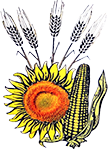Local Populations of Millet (Panicum Miliaceum) an Option for Improving the Resilience
and Biodiversity of Agroecosystems
Victor Petcu 1,2, Mihaela Ioniță3, Ionuț Stan3, Tudor Andrei Zaharia3, Ioana ClaudiaTodirică2,
Marcel Theodor Paraschivescu2, Petruța Simona Simion2
1Institutul Național de Cercetare Dezvoltare Agricolă Fundulea
2Centrul de Studii și Cercetări de Biodiversitate Agrosilvică "Acad. David Davidescu", București
3Universitatea de Științe Agronomice și Medicină Veterinară București
Keywords: millet, local populations, tillering capacity, leaf area, panicle characteristics, production, organic agriculture.
Abstract: Millet, "Proso millet" (eng), (Panicum miliaceum), with the number of chromosomes 2n=4x=36, is one of the oldest crops used in Asia and Europe. Originating in China, it has spread to India, the Middle East, Russia and all of Europe. Its spread was diminished by the 18th century, with the advent of corn and the potato. In the current situation of climate change, the importance of millet (Panicum miliaceum), has increased due to the ability to support production on water-poor lands, the short vegetation period (70-100 days), the minimum requirements for fertilizers, a superficial preparation of the soil but and low sowing rates of only 25-30 kg/ha. In this context, alternative crops such as proso millet present a viable option to diversify our diet and contribute to food security.
This paper provides existing relevant information on the genetic diversity and yield capacity of 11 millet populations (from the Gene Bank in Suceava, Romania) compared to those of the Marius variety (property by NARDI Fundulea, Romania) in the ecological agriculture system. Tillering capacity, leaf surface, panicle length, panicle width, panicle density and production were analyzed. The obtained results showed a genetic diversity for the characters studied and production. Although the year was very dry, in five of the local populations studied the productions obtained were over 1000 kg/ha. A population with a higher production capacity (1500 kg/ha) compared to the production of the Marius variety (1030 kg/ha) was identified, which opens the way for genetic progress to obtain a more productive variety for the organic farming system as well as for improving the resilience and biodiversity of agroecosystems.
